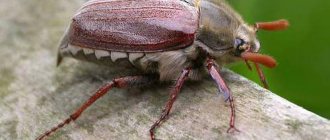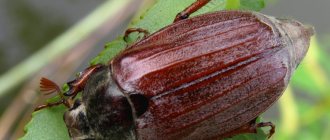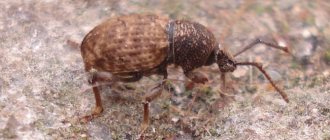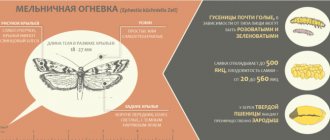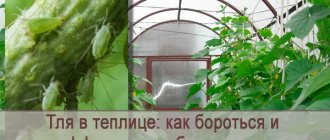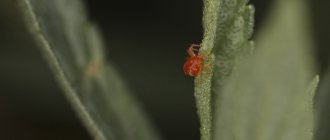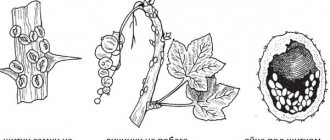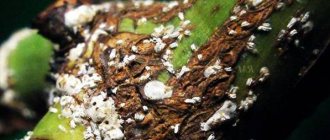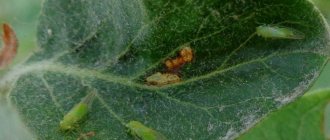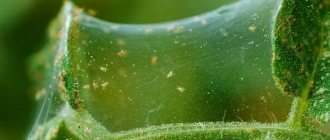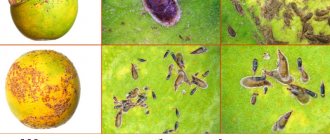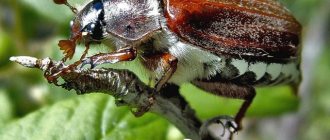The cockchafer is a dangerous pest of green plants. It causes double harm not only to vegetable and garden plants, but also to tree crops in gardens, forests, and parks. Adult individuals of the cockchafer can be classified as gourmets. They prefer the leaves of oak, birch, maple, poplar, linden, and rowan to other forest and park species. They are not interested in herbaceous weeds and cultivated plants. Sometimes in May you can see short garlands of chafers on these trees. The life span of an adult beetle is quite short and it does not have time to cause significant harm, but its larvae, with a multi-year development cycle, are less picky in their diet and are able to quickly destroy significant areas occupied by agricultural crops.
May beetle, or May beetle (Melolontha). © Anthony White
Distribution of the cockchafer
May beetle , or May beetle (Melolontha) is an interesting buzzer for children and one of the most dangerous pests due to its omnivorous nature and distribution area. Currently, out of 24 (according to other sources - 74) species, 9 are widespread in Russia. May beetles have everywhere populated the forest-steppe and forest zones of Europe and Asia. In the Russian Federation they are found everywhere from the southern outskirts to the Siberian taiga. The distribution area of the pests covers almost the entire territory of the European part, including the regions of Central Russia. In the Asian part it is distributed to Kamchatka. Found everywhere in the Caucasus and Transcaucasia.
Danger level of the cockchafer
The beetle's danger level is quite high. Presence of 1 larva per 1 sq. m area is the threshold of harmfulness of the cockchafer. A survey of forest and park lands, garden plantings in some regions recorded the presence of 2 - 3, and near forest belts - up to 20 or more larvae per square meter. m.
Under favorable conditions, there is a rapid increase in the number of the pest and a period begins, after about 20-25 years, of mass flight, which lasts up to 3-4 years. An approximately 10-year break is necessary for cockchafers to intensify reproduction before the start of the next mass flight with the capture of new areas.
What crops does the cockchafer damage?
Adult chafers appear in early May when warm weather sets in. During this period, they cause harm by feeding on young leaves and flowers of all garden, park and forest plants. Cold weather causes imago torpor and even death when spring frosts return. Adults are most harmed in the spring when they emerge from the pupa. The main concern of an adult insect is to leave offspring. For 1-2 months a year, adult female cockchafers feed intensively and lay eggs.
4-6 weeks after the imago emerges, the next generation of larvae hatches from the eggs, and the larvae of previous years of hatching are activated. They live in the soil for up to 4 years, going through 6 stages of maturation. They constantly migrate in the vertical soil horizon. In winter they go to the lower horizons up to 50 cm, and in the spring they return to the root layer with the soil warming up to +10..+15 °C. The larvae of the May beetle throughout the entire period of their life, except for the pupal stage and the period of hibernation, constantly gnaw on everything that is in the soil. Unlike adult May beetles, they gnaw at the roots of weeds, vegetable and garden plants, mature garden and forest trees, berry beds, shrubs and other types of plants.
The larvae gnaw the roots of strawberries/strawberries, black and other types of currants. Especially a lot of them gather at the roots of apple and cherry trees. In parks and forest edges, cockchafer larvae settle at the roots of aspen, birch, cedar, spruce and other plants. Observations have established that a 3-year-old larva is capable of destroying the root system of a 2-year-old pine in 1 day, and a 2-year-old larva will feed on the roots of the tree for a whole week. There is currently a 10-year hiatus in flight. New cockchafer larvae hatch from the laid eggs, previously born ones grow up, and the larvae reproduce intensively in soil conditions.
May beetle larva. © a-evans
What does the cockchafer and its larvae look like?
Let's look at the most popular and effective methods of pest control.
Sodding is a method by which the soil is naturally enriched with nitrogen. This can be achieved by sowing white clover in the required areas of the garden. Experts have proven that the roots of this plant contain a special bacterium that is capable of saturating the soil with nitrogen and transferring it to the root system of nearby growing plants.
It is nitrogen that is the most unattractive environment for the life of the larvae of this beetle. This method is the simplest, but at the same time the least effective. In order to achieve results, you need to loosen the soil throughout the summer.
Collecting larvae is the cheapest method of getting rid of the cockchafer, but it also requires a sufficient amount of time from the garden owner. This is a rather labor-intensive process, which is recommended to be carried out in the summer, since at this time the larvae rise closer to the surface of the earth, feeling the heat.
Note! If you choose this method, then you will need to dig up the entire area to a depth of about 15 cm and collect all the larvae with your hands. But you should understand that with this method it will not be possible to collect all the cockchafer embryos.
Treatment with chemicals is a method for those who want to free their area from cockchafer larvae as quickly as possible. For this type of fight against a malicious pest, the drugs “Actofit”, “Fitoverm” and “Boverin” are most often used. Biological components are the basis of these drugs, so they are considered quite harmless to humans and some beneficial insects.
You can get rid of an adult May beetle using the Anti-Khrushch product, but it also has a negative effect on all other insects. If fruits and berries appear on your trees or bushes, then this product cannot be used, since it has a decay period of 45 days.
Traditional methods are used only at the initial stage of insect infestation.
There are a sufficient number of different tinctures that are used to eradicate the larvae of the cockchafer:
- tincture of sunflower flowers;
- tincture on the stems and leaves of wormwood, which are mixed with wood ash (300 g of dry mixture per 200 g of ash is poured into a bucket of hot water);
- tincture on walnut leaves;
- tincture on dry white acacia bark (suitable for treating affected plants).
Also, a good folk method for fighting larvae is a solution obtained by adding 10-15 drops of iodine to water and a solution based on onion or garlic peels, which is infused for several days. The last liquid of the plant is watered at the root, having previously diluted it with water.
You cannot be lenient about the colonization of a garden by cockchafers, because in a very short period of time you can lose valuable plants. Pets can help in the fight against the beetle: ducks, geese, chickens love to feast on fatty beetles, looking for them in the grass under the trees.
Wild animals that inhabit areas adjacent to the garden and run in to eat carrion also help get rid of beetles. Snakes, prickly hedgehogs, moles and lizards are capable of destroying most of the beetle population, but they do not save you from the entire armada of pests.
Chafer beetles can travel vast distances, looking for suitable places to lay eggs, so protecting the garden from the beetle is an urgent and urgent need.
The cockchafer is a dangerous pest in the garden. Therefore, combating it is mandatory to preserve the harvest. It is best to catch insects using different traps. You can catch the cockchafer using the following methods:
- hand catching,
- light trap,
- glue trap.
Light trap
To prepare a light trap:
- You need to prepare a small container and coat its inner surface with a sticky substance.
- Attach a light source to the bottom of the container. A flashlight or a standard electric lamp will do. Next, wait until nightfall.
- At night, set up an improvised trap in an open area. Thus, the unwanted guest flies into the light, getting inside the sticky liquid. In addition, there are other types of insects that cause harm.
Glue trap
To prepare a glue trap, you need to purchase a sticky substance for flies at any store, then apply it to paper or newspapers. This liquid attracts cockchafers, which stick to the paper.
Natural enemies
Hedgehogs feed on cockchafers of all ages. Therefore, when a swarm of insects appears, you need to try to provide the prickly helpers with decent living conditions on the site. Then they will independently and quite effectively fight the pest.
The presence of starlings and crows in the area also helps. Winged helpers can find them even underground and successfully dig them out from there. Therefore, installing birdhouses is a good control method.
Important! Also natural enemies are field mice and rats. Animals living in burrows often encounter individuals of the cockchafer, eating them.
Description of the cockchafer
The cockchafer is a major pest. The body length of an adult insect reaches 3.5-4.0 cm. The body of the beetle is barrel-shaped, elongated at the rear into a process, black or brownish-brown, sometimes reddish in color. The body is covered with small hairs. They are longer on the head and soft underwings. The beetle is dense due to its strong outer chitinous skeleton. Female chafers are different from males. Sexual dimorphism upon external examination is manifested in the length of the antennae: in females they are short, in males they are long, resembling a curved club in shape.
Description of the pest
The genus May beetle (Khrushchev) includes 24 species, 9 of them were found in Russia.
Insects appear as soon as the buds and leaves bloom on the trees. They crawl out of the ground, where they spend more than one winter.
These are quite large insects up to 35 mm in size. They are found in Europe and Asia, preferring forests and forest-steppes. In populated areas, Khrushchi are localized in plantings and gardens. They live and mate on trees and bushes, and lay eggs in the soil.
Based on their color, there are two types of May beetles:
May beetle nigripes.
rex, or red ones , which are characterized by a red pre-back and legs (live in places with weak shade, found in the northern regions);- nigripes, or black , with the same color on the back and legs (live in shady forests, mainly in the south).
It's easy to recognize a beetle:
- the body is covered with hair-like scales, the pile is longer on the head and foreback;
- there are antennae on the head, on which males have 7 identical plates, forming something like a club;
- has 3 pairs of limbs covered with hairs, with claws at the ends for crawling on bark and foliage;
- the wings are strong, chitinous, brown in color, attached to the second segment, transparent lethal - to the third.
4–6 weeks after the eggs are laid, white worm-like larvae hatch and remain in the soil for up to 4 years. They have a well-developed oral apparatus, which allows them to feed on plant debris and root shoots.
At the end of the last year of life in the ground, transformation into a pupa occurs. At this stage, the insect resembles an adult, but is still white in color, with underdeveloped wings. Gradually, under the influence of hormones, it finally turns into a beetle (usually this happens at the end of summer), but it emerges from the ground only next spring.
Development cycle and reproduction of cockchafers
The development cycle of the cockchafer lasts 4-5 years. In the second half of May, adult sexually mature females appear, whose life is limited to mating and laying eggs (50-80 pieces) in the upper 15-20 cm layer of soil. After laying, the females die. After 1.0-1.5 months, white larvae hatch. Small and weak, in the first year they remain at the site of hatching and feed mainly on soil organic matter (humus). Starting from the second year, they spread in the soil, occupying new areas.
The cockchafer larva lives and feeds in the soil for 3-4 years. During this time, it goes through several stages of development, then, approximately in the middle of summer of the 4th year, it enters the stationary pupa stage. An adult beetle emerges from the pupa - an imago, which only appears on the surface of the earth in the spring, begins to feed intensively and starts a new development cycle. At the same time, a huge number of larvae of different ages remain in the soil. Young females replenish the supply of eggs, annually increasing the generation of larvae by 70-200 pieces each.
More traditional insect dishes
Casu marzu cheese, or wormy cheese from Sardinia
Translated from Sardinian, casu marzu literally means rotten cheese. Its other names: casu modde, casu cundhídu, casu frazigu.
Casa marzu is made from regular Sardinian pecorino, but is aged longer. The larvae of the cheese fly accelerate the process of decomposition and breakdown of the fats contained in the cheese, which is why the cheese becomes soft and a liquid called lagrima (“tear”) is released from it. This gives the cheese an unusual taste.
Sardinian wormy cheese - casu marzu.
The larvae, when disturbed, are able to jump up to 15 cm. For this reason, those who want to taste the delicacy while eating are better off wearing glasses in advance or removing the larvae. In addition, kasa marza needs to be chewed very carefully so that there are no unpleasant consequences later. Possible parasitism of larvae in the human intestines and allergic reactions. In general, this is not an easy meal for an unprepared gastrotourist.
By the way, you can only try this cheese in Sardinia, since, according to epidemiological regulations, it is prohibited to transport it across the border.
Cheese Mimolette, or cheese with mites from France
Traditionally produced in the vicinity of Lille in France, where it is known as Boule de Lille - "Lille ball", and in Flanders - vieux Hollande - "old cheese".
In this case, during ripening, a population of cheese mites settle on the surface of the cheese, which gnaw passages in the rind and affect the taste: a special bitterish tint is obtained in the fruity taste.
French cheese with mites Mimolet.
This cheese is considered safer to eat than Sardinian cheese. However, since April 2013, Mimolet has been banned from import into the United States as “unfit for consumption because it may cause allergies.” Earlier, in 2012, 60 tons of this cheese were imported to the United States.
Read more about Mimolet cheese at Gastromom.ru
Signs of plant damage by the cockchafer
Adult beetles eat leaf blades, buds, partially ovaries and young needles. When damaged by larvae, without visible external causes, plants begin to wither, lag behind in development and die. Herbaceous plants are easily pulled out of the soil. Dead seedlings must be carefully dug up and the soil checked for the presence of larvae. They are usually large, with a dark head, curled into a "C" shape. On the underside of the segmented body there are 3 pairs of thoracic and 5 pairs of abdominal legs. If larvae are detected, it is necessary to urgently take measures to protect against the pest.
Development cycle of the cockchafer. Illustration from volume II of the encyclopedia “Fauna of Germany” by Edmund Reitter. 1908
How to deal with the cockchafer?
An important agrotechnical measure is the collection and destruction of cockchafer larvae during autumn and spring digging of the site. The optimal temperature for larvae is +24..+26 °C. They have not yet gone deeper for hibernation, but in the spring they already move closer to the roots of plants in the upper 10-20 cm layer of soil.
May beetles have natural enemies (entomophages) that feed on insects. To attract them to the garden, you can sow dill, cumin, fennel, anise, and coriander in different parts of the plot. Sunflower, phacelia and other nectar-bearing plants are attractive to entomophages.
If it is impossible to systematically care for the garden, it is better to sod it. Female cockchafers (like winter cutworms) will not be able to penetrate the turf into the soil, which means they will not lay eggs.
If permanent sodding is not provided, insecticidal plants can be used. Thus, the larvae of the cockchafer cannot tolerate high nitrogen content in the soil and leave such places. You can sow white clover, peas, beans, legumes and other crops that are nitrogen fixers under the tree trunks, and in the fall you can incorporate them into the soil as green fertilizer when digging.
May beetles and their larvae cannot tolerate the smell and secretions of lupine and mustard. The larvae die of starvation, since there are no weeds around the lupine to feed on, and the beetles immediately fly away from these hated plants. Mustard is an excellent green fertilizer; when incorporated into the soil, it will contribute to the death of the larvae.
The larvae of the cockchafer cannot tolerate chloride compounds. If larvae are found in the soil, you can switch to applying chlorine-containing fertilizers or, when digging, add a little bleach randomly.
Breeding birds and hedgehogs on the site, which actively destroy adult cockchafers and their larvae. You can hang traps with bait.
At the end of April - May, the emerging May beetles, at a temperature not higher than +12..+15 ° C, sit in a pre-dawn daze on the branches of trees. At this time they are shaken off and collected.
In the garden, green manure from mustard, white clover, peas and other crops, especially cruciferous crops, should be systematically used. Plant tall plants (potatoes, eggplants, corn, etc.) in white clover. The nodule nitrogen on clover roots will drive out the May beetle larvae and serve as green fertilizer for cultivated plants. During the summer (as green manure), clover is mowed between the rows.
Accumulation of cockchafer larvae under the turf. © Pitchcare
Benefits of the summer beetle
It is difficult to underestimate the destructive activity of this pest in relation to trees and other plants. Khrushchev does not perform any useful actions in its entire life, except for its use in fishing.
Avid fishermen and just hobbyists often use fatty caterpillars as bait on the hook of a fishing rod. This bait is attractive to many predator fish:
Using an adult is no less successful for attracting fish. You just need to throw a few beetles into the water and wait until they become dinner for your future catch. Then you can safely throw the rod into the feeding area. It is recommended to put the beetle on a hook. The insect will flounder in the water and attract fish.
Collecting bait is carried out as follows:
- Adult pests can be collected by hand by shaking tree branches.
- Many individuals are easy to find near street lamps. In the twilight hours, they are attracted by the bright light of the lamp, which, when burned, causes the beetles to fall to the ground.
- Extracting larvae will not take the fisherman much time if you dig up the top layer of soil in the garden or vegetable garden between the beds. The fatty bait is collected by hand into a jar with soil.
This method of using pests can significantly reduce their number within your summer cottage or garden. But it is very difficult to get rid of all the culprits of plant death. Only by applying an integrated approach to their destruction can the majority of garden crops be saved.
Chemical measures to combat the cockchafer
Naturally, the use of chemicals in a summer cottage is not encouraged, but for those who like to quickly destroy all living things, we can recommend the following chemicals for destroying cockchafer larvae.
Pochin and Zemlin are insecticides of contact and intestinal action. When shallowly incorporated into the soil, they begin to actively influence the larvae within 24 hours, especially young ones that feed on humus. For 10 sq. m area, add 15-20 g of powder or granules of a chemical preparation. These preparations can be applied to the hole when planting potatoes and other plants.
Aktara , Bazudin , Vallar are contact-intestinal insecticides that kill soil pests. They are used mainly for treating the roots of planted plants, as well as surface application to the soil in the form of solutions or a dry form of the drug.
When using chemicals, be sure to follow the instructions for dilution and application. When using soil-acting insecticides, there is no need to treat the above-ground mass of plants (except for special instructions in the recommendations).
Antichrusch is a drug with a long period of influence on the pest. Before use, the suspension concentrate is diluted to a working solution according to practical instructions for vegetable crops, seedlings and shrubs. The roots of the plants are soaked in the solution and the working solution is poured under the root.
Among chemical agents, you can use a solution of ammonia water for future plantings of strawberries/strawberries. Dissolve 200 g of ammonium nitrate in 10 liters of water per 1 sq. m area 3-4 months before planting seedlings. This technique will get rid of beetles and their larvae for many years.
Khrushchi especially love the tender roots of strawberries. For preventive purposes, you can add a solution of ammonia (a tablespoon/bucket of water) under the strawberry roots.
May beetles, or May beetles (Melolontha). © Jude Lock
Features of development and behavior
The flight of beetles occurs from the 2nd half of May to the end of June, isolated flights are observed until the beginning of August. But in the southern regions, the flight of beetles already begins in the 3rd decade of April.
Usually, single males appear first, and after a week the females begin flying. Beetles begin to fly at dusk, after sunset. By midnight the flight stops. During flight, beetles sit on trees and feed. Beetles can fly out in the morning as well as at night, reacting to artificial lighting.
Different types of beetles are active at different times of the day. Both males and females fly equally well. But in some species, females fly little or not at all.
May beetle (Khrushchev) in flight
By the way, the flight of the cockchafer is a mystery of nature. According to the laws of aerodynamics known to mankind, a beetle with such a body should not fly. Its wings are not developed enough to lift such a body into the air. But the cockchafer does not know about this, and flies at speeds of up to 3 m/sec. In a day it can fly up to 20 km, rising to a height of up to 100 m.
The cockchafer lives 5-7 weeks.
And the larvae live in the soil for 2-3 years, and
Biological measures of protection against the cockchafer
At home, it is better to use appropriate biological products for all garden, berry, vegetable and other crops and flower beds. They purposefully kill pests without harming the health of people and animals.
One such biological product is Nemabact . The biological product, being introduced into the body of the cockchafer larva, kills the pest within 3 days. The concentrate is diluted in a ratio of 1:100. Work with the drug at an air temperature not lower than +25..+26 °C. Apply to moist soil after watering or before watering.
Aktofit , Boverin , Fitoverm , developed on the basis of soil Effective Microorganisms (EM microflora), effectively destroy the larvae of the cockchafer
Before using biological products, be sure to study the recommendations. Self-dilution with increasing concentration of the working solution will not have a negative effect on pests, but may cause plant disease.
The larva of the cockchafer gnaws at the root of the plant. © Meret Huber
Folk techniques for fighting the cockchafer
Experienced gardeners recommend an infusion of onion peels in a ratio of 100 g/10 l of water, leave for a week and treat the soil under the plants. To spray plants, dilute the solution again in a 1:1 ratio.
If 1-2 larvae or adult beetles were found in the spring, then it is necessary to add (1%) to the soil and treat the plants (0.1%) with a solution of potassium permanganate .
When cultivating the soil in spring, you can add freshly slaked lime or a chlorine-containing preparation . The smell of lime and chlorine will repel beetles trying to lay eggs.
A solution of ammonia will drive away the beetles . Use a solution of 20 ml per 10 liters of water and spray the plants in the fall. The beetles will leave without forming oviposition on the planting.
